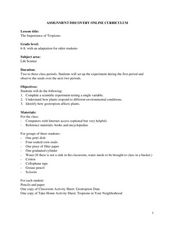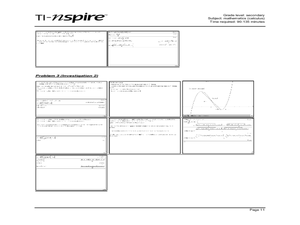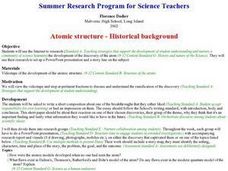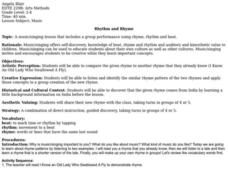Curated OER
CAN'T TOUCH THIS!
Students discover the best practical shielding material when dealing with radioactive substances. They draw conclusions based on availability of materials, price, and best shielding properties.
Curated OER
Migrant Workers Through the Lens of Dorothea Lange
Students explore the lives of migrant workers during the Great Depression. In this Great Depression lesson, students examine photographs and song lyrics to gain an understanding of the conditions for people living in the era. Students...
Curated OER
Pond Ecology
A lab activity is a great way to incite thoughtful questioning and scientific processes. Pupils will collect organisms with a Petri dish, make observations, sketch the organism, ask questions, then attempt to identify the specimen...
Curated OER
Lewis and Clark: Prized Possessions
Young scholars consider the role of Sacagawea as part of the Corps of Discovery. In this Lewis and Clark expedition lesson, students discover details about Sacagawea's wampum belt and then create their own wampum belts using their...
Curated OER
Erosion Lab
Eighth graders explore variables that influence the rate of erosion due to the 4 major agents. They work as a group and practice conducting experiments according to the scientific method. Students comprehend that communicating ideas...
Curated OER
Living and Nonliving
Students use their senses to record and collect data. In How Do I Classify Things in My World?, students practice classifying objects as living or nonliving. In Is it Real Or Pretend?, students group objects as real or pretend. In What...
Curated OER
Atomic Structure and Bonding
Eighth graders discuss and write about what led up to the discovery of the atom. Students label proton, nucleus, electron, and neutron in their notes. Students take notes on electron shells and how different atoms have different...
Curated OER
Plant Pollination
Students investigate methods of pollination for various flowers. In this plant biology lesson, students learn the parts of a flower and form a hypothesis about the method of pollination for the flower. They determine the validity of...
Curated OER
The Importance of Tropisms
Middle schoolers investigate plant tropisms using the scientific method. In this life science lesson, students learn about tropisms and test the response of corn seedlings to gravity. Response questions, extensions, and an...
Curated OER
Two Investigations of Cubic Functions
Through learning about cubic functions, high schoolers graph cubic functions on their calculator. Students determine the local maximum and minimum points and the tangent line from the x-intercept to a point on the cubic...
Curated OER
Brown Bag Science
Students discover, through the discovery method, how electricity works. They construct a simple circuit and a parallel circuit, make an electrical motor work and add a switch to turn it on and off.
Curated OER
"Adding It Up" at James Fort
Students discuss jettons and their archaeological importance at Jamestown. They then practice using historic counting sheets and artifacts to understand the calculating methods of the early 17th Century, and identify their similarities...
Curated OER
Evolutions of Pottery
Young scholars study the history and importance of clay and pottery. They observe a video dealing the kiln. Students explore ideas for improving construction of pottery. They demonstrate a variety of construction methods and identify...
Curated OER
Discovery
Students explore patterns in number problems. They devise a strategy to solve a number problem. Students estimate and calculate answers, making efficient use of a calculator, where appropriate, as part of solving a problem. They...
Teach Engineering
Imagining DNA Structure
Let's get a closer look at DNA and other molecular structures. The first lesson in the series of four introduces a variety of imagining techniques that engineers and scientists use to visualize molecular structures. The resource presents...
NOAA
To Explore Strange New Worlds
It's time to boldly go where your class has not gone before! The introductory lesson in a five-part series takes young oceanographers aboard the NOAA Ship Okeanos to begin a study of ocean exploration. The lesson includes a comparison of...
Curated OER
Let Your Motto Be Resistance: African American Portraits: Grades 3-5
Students explore the contributions of African Americans of the 20th century. In this African American history lesson, students examine portraits of Muhammad Ali, Romare Bearden, Lorraine Hansberry, Judith Jamison, and Leontyne Price in...
Curated OER
Atomic structure - Historical background
Students use the Internet to research the development of the discovery of the atom. They create an essay, PowerPoint presentation and a story line on the subject.
Curated OER
Archeological Finds
Students explore archeology and it contributions to human history. They write a magazine article describing the discovery of a dig.
Curated OER
Rhythm and Rhyme
Students listen to and identify the similar rhyme pattern of two rhymes and apply those concepts to a group creation of a new rhyme. They discover that the given rhyme comes from India by learning a little background information on India.
Curated OER
Timeline Shuffle
Pupils examine the role and importance of timelines, and the method for ordering events. They order events and create a timeline of significant technology achievements and scientific discoveries in order from earliest to the most recent.
Curated OER
Pictograph Stone Carving
Students examine pictures of pictograph writing by Native American tribes, and discuss why this method of communication was used. They create their own messages with symbols and drawings on pieces of Styrofoam to simulate rock carvings.
Curated OER
How Can We Organize Study of a Given Place?
Seventh graders embark in discovery of basic facts about an assigned continent and are asked to organize their information into categories. The Five Themes model is taught and students reshuffle their information appropriately.
Curated OER
Heron's Formula
Students use Heron's formula to calculate the area of a triangle. In this geometry lesson, students use three different methods to solve the area of a triangle. They find and construct the incentor and angle bisector of a triangle.























